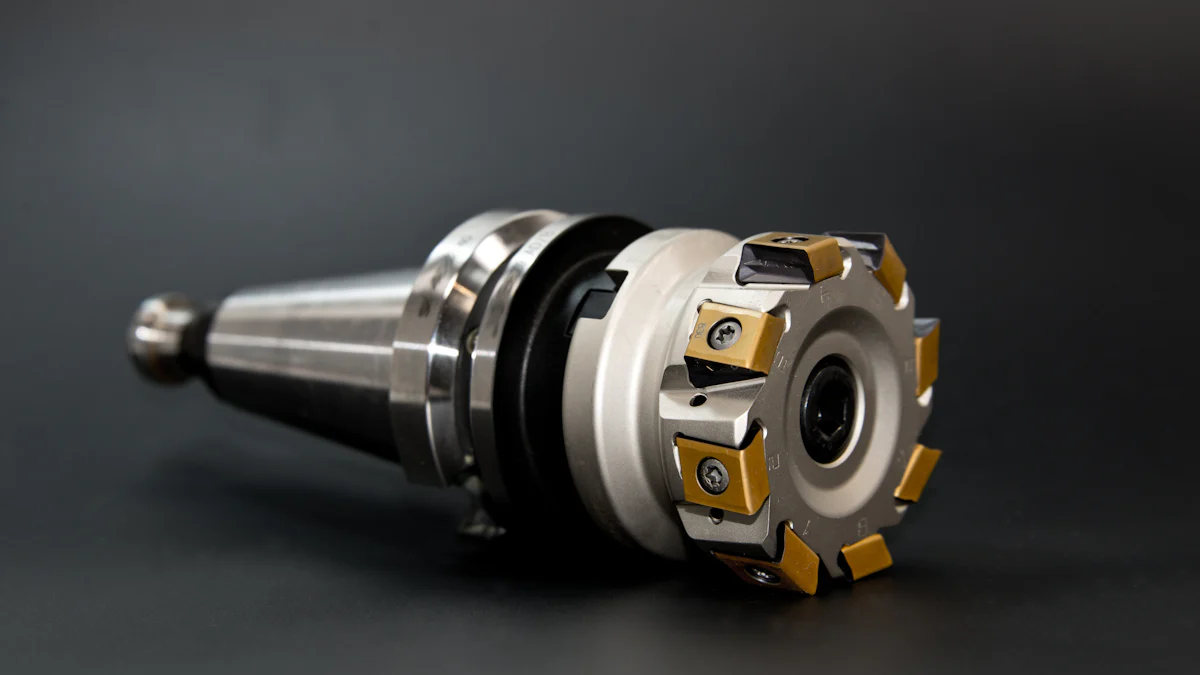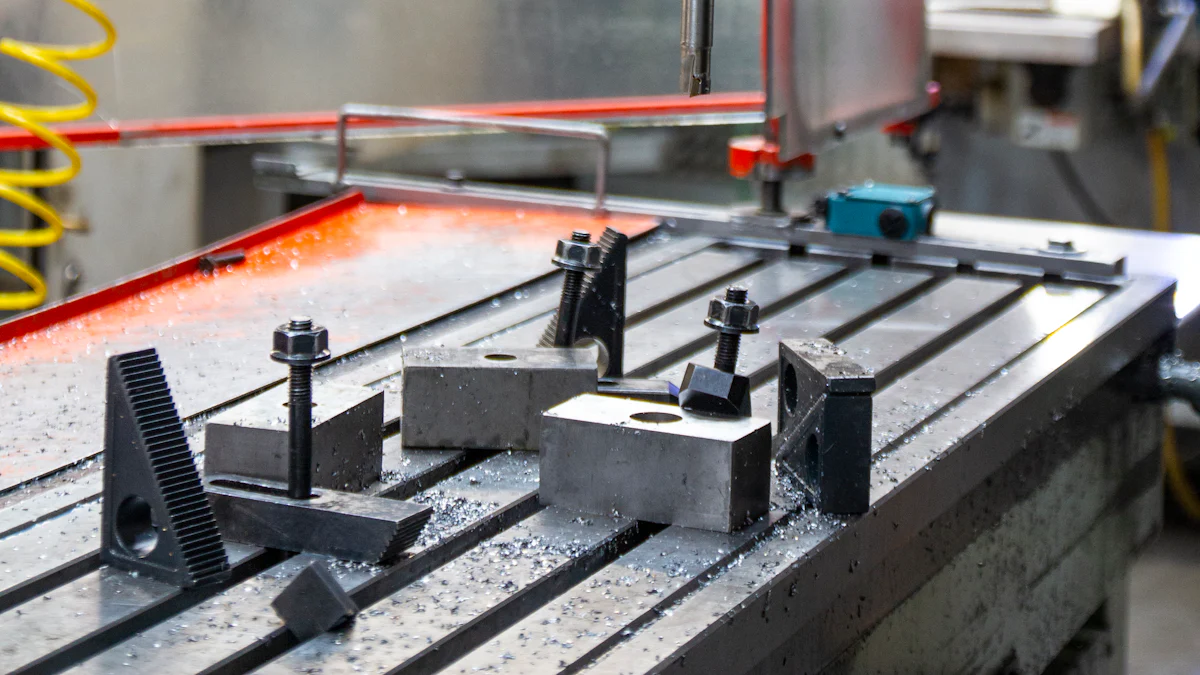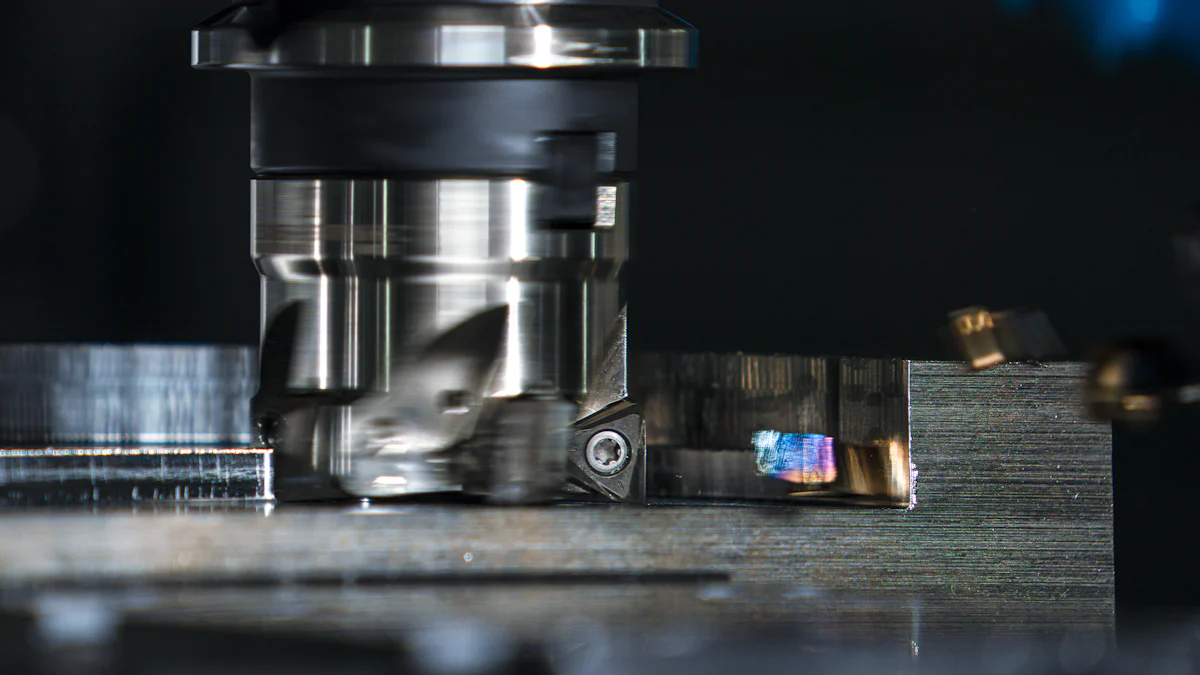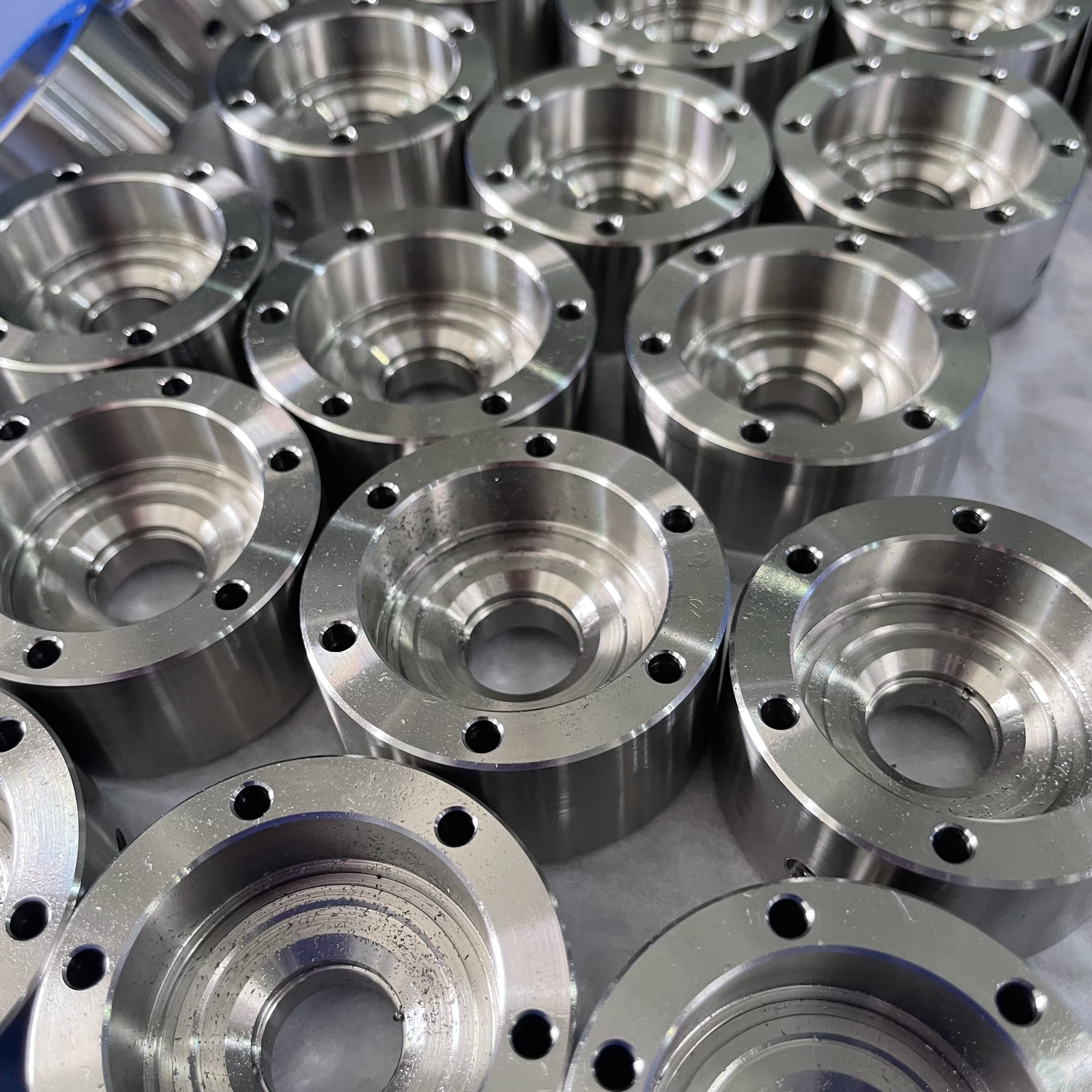How Advanced CNC is Shaping Aluminum Machining

Advanced CNC technology is transforming aluminum machining by delivering exceptional precision and efficiency. You can see its impact across industries like aerospace, automotive, and medical devices. For example, 5-axis CNC machining reduces manual adjustments, improving workflows and surface quality. In aerospace, it enables the creation of lightweight, high-strength parts like turbine blades. The global CNC machining market reflects this growth, projected to reach USD 129.9 billion by 2027 with a steady CAGR of 6.8%. This technology not only enhances productivity but also minimizes errors, ensuring consistent quality in every application.
Key Takeaways
Advanced CNC machines improve accuracy and speed in aluminum cutting. They are important for industries like airplanes and cars.
Using 5-axis CNC machines makes complex shapes in one step. This saves time and makes parts more exact.
Recycling aluminum and using energy-saving machines help the planet. These actions also lower costs for businesses.
AI and automation in CNC systems make work faster and easier. They can also predict repairs and boost productivity.
Diamond-coated tools last longer and work better. They help make higher-quality parts.
Key Benefits of Advanced CNC Machining in Aluminum

Precision and Accuracy in Aluminum Machining
Advanced CNC machines deliver unmatched precision, ensuring consistent quality in aluminum machining. You benefit from high-level precision control systems that enhance accuracy and repeatability. This means every part produced meets exact specifications, reducing errors and waste. Adaptive feed rates further improve machining by automatically adjusting to the cutting load. This feature optimizes performance when working with varying aluminum properties.
Improvement Type | Description |
|---|---|
Precision Controls | High-level precision control systems enable better accuracy and repeatability for consistent parts. |
Adaptive Feed Rates | Automatic adjustment of feed rates based on cutting load enhances efficiency with varying aluminum properties. |
The increased precision and accuracy offered by advanced CNC machining make it indispensable for industries requiring high-quality components, such as aerospace and medical device manufacturing.
Enhanced Efficiency and Productivity
CNC machining services significantly boost production efficiency by minimizing waste and maximizing output. Real-time adjustments during machining reduce material wastage, which is especially important when working with high-cost aluminum. Electrochemical Machining (ECM) eliminates residual stresses and heat damage, making it ideal for delicate components. You also gain the advantage of superior surface quality, often eliminating the need for secondary processes.
Minimized Waste: Real-time adjustments reduce material wastage, crucial for high-cost aluminum.
Stress-Free Machining: ECM prevents residual stresses and heat damage, ideal for delicate components.
Precision for Complex Geometries: ECM excels in creating intricate shapes, beneficial for aerospace and automotive industries.
No Tool Wear: The absence of direct contact between tool and workpiece virtually eliminates tool wear, extending machine tool life.
Superior Surface Quality: ECM provides excellent finishes, often negating the need for secondary processes.
For example, CNC machining at CNCRUSH has improved system reliability in advanced robotics by delivering ultra-precise components. This demonstrates how greater automation and integration in CNC manufacturing can transform production workflows.
Material Optimization and Sustainability
The importance of sustainability in aluminum machining cannot be overstated. Aluminum is highly recyclable, allowing you to reduce environmental impact by recycling chips and offcuts. Recycling aluminum requires far less energy than producing new material, making it an eco-friendly choice. Closed-loop systems conserve water by treating and reusing wastewater, while advanced filtration methods improve water quality. These practices lower energy consumption and reduce waste sent to landfills, helping you achieve a smaller carbon footprint.
By adopting advanced CNC machining, you align with industry 4.0 principles, focusing on sustainability and resource efficiency. This approach not only benefits the environment but also opens up new opportunities in green manufacturing.
Technological Innovations in CNC Machining
AI and Machine Learning in CNC Systems
AI and machine learning are transforming CNC machining by introducing smarter, more efficient processes. You can now rely on AI to optimize cutting paths, predict maintenance needs, and make real-time adjustments during machining. These capabilities reduce waste and improve production speed, ensuring you achieve high precision in every project. AI also automates repetitive tasks, allowing you to focus on more complex operations while maintaining consistency and quality.
The integration of AI into CNC systems has revolutionized aluminum machining. It enhances efficiency, lowers production costs, and delivers better results. For example, AI-driven systems can analyze data from previous machining cycles to refine future operations. This leads to advances in accuracy and precision, making AI a cornerstone of advanced CNC machining.
Automation and Robotics in Aluminum Machining
Automation and robotics are driving the future of CNC machining by enabling greater automation and integration. Collaborative robots, or cobots, work alongside human operators, adapting to various tasks and ensuring safety. You can benefit from flexible manufacturing systems that allow quick adjustments for diverse production needs. These systems are particularly effective when working with aluminum alloys, which are lightweight and corrosion-resistant.
A challenge in aluminum machining often involves the need for automated solutions for complex tasks like extrusion machining.
Solutions such as advanced motion control systems and integrated controllers enhance machining capabilities.
The results include increased productivity, seamless integration, and reduced programming time.
By adopting automation and robotics, you can improve product quality and streamline operations, making your processes more efficient and sustainable.
Advancements in 5-Axis CNC Machining
5-axis CNC machining represents a leap forward in high-tolerance machining. This advanced technology allows you to produce intricate aluminum parts with exceptional precision and surface finish. It reduces the need for multiple setups, saving time and improving productivity. You can create complex geometries that traditional methods cannot achieve, making it ideal for industries like aerospace and medical devices.
The versatility of 5-axis CNC machining opens up opportunities for customization across various applications. It also minimizes tool marks, ensuring a superior surface finish for aesthetic or functional purposes. By leveraging this technology, you can meet the growing demand for high-precision components while maintaining efficiency and quality.
Diamond-Coated Cutting Tools for Longevity
Diamond-coated cutting tools play a crucial role in extending tool life and improving machining performance. These tools feature a thin layer of synthetic diamond coating, which provides exceptional hardness and wear resistance. When you use diamond-coated tools for aluminum machining, you benefit from reduced tool wear, longer operational life, and enhanced cutting precision.
Key Advantages of Diamond-Coated Tools
Superior Hardness: Diamond is one of the hardest materials on Earth. This property allows the coating to withstand high cutting speeds and abrasive materials.
Reduced Friction: The smooth diamond surface minimizes friction between the tool and the aluminum workpiece. This reduces heat generation and prevents material buildup.
Extended Tool Life: With diamond-coated tools, you can complete more machining cycles before needing replacements. This reduces downtime and lowers overall costs.
Improved Surface Finish: These tools deliver a smoother finish, eliminating the need for extensive post-processing.
💡 Tip: Use diamond-coated tools for high-speed machining of aluminum alloys. They perform exceptionally well in applications requiring tight tolerances and fine finishes.
Applications in Aluminum Machining
Diamond-coated tools excel in industries where precision and durability are critical. For example:
Aerospace: You can machine lightweight aluminum components like airframes and turbine parts with high accuracy.
Automotive: These tools help create intricate engine parts and lightweight structures.
Electronics: They are ideal for machining aluminum casings and heat sinks.
Feature | Benefit |
|---|---|
Hardness | Withstands high speeds and abrasive wear |
Low Friction | Reduces heat and material buildup |
Longevity | Extends tool life and reduces downtime |
By adopting diamond-coated cutting tools, you enhance productivity and achieve superior results in aluminum machining. These tools are an investment in quality and efficiency, ensuring your processes remain competitive and cost-effective.
Industry Applications of Advanced CNC Machining

Aerospace and Defense
Advanced CNC machining plays a critical role in aerospace and defense, where precision and reliability are non-negotiable. You can see its impact in the production of components like turbine blades, engine casings, and fuel nozzles. These parts must endure extreme conditions while maintaining tight tolerances to ensure safety and performance.
CNC systems enable the creation of complex designs using advanced materials like titanium and superalloys. For example:
Lockheed Martin uses 5-axis milling machines to precisely machine the composite skin of the F-35 fighter jet.
Northrop Grumman employs CNC machines to drill and trim fuselage skins, improving efficiency by 30%.
General Atomics relies on CNC machining for core cutting in Predator drones.
In defense, CNC machining supports the production of barrels, receivers, and armor plating. It also ensures smooth finishes for radar systems and critical components in naval craft, such as propulsion and communication systems. By leveraging CNC technology, you can achieve high precision and repeatability, which are essential for mission-critical applications.
Automotive Manufacturing
CNC machining has revolutionized automotive manufacturing by enhancing efficiency and precision. You can rely on CNC systems to produce parts with tight tolerances, ensuring reliable operation. Automated processes reduce human error, speeding up production and lowering lead times.
CNC machining supports innovative designs by enabling the creation of complex geometries. This flexibility is invaluable for rapid prototyping and the development of lightweight, fuel-efficient vehicles. For instance, CNC systems optimize resource usage, reducing waste and overall manufacturing costs. Consistency across production runs ensures uniform quality, meeting the high standards of the automotive industry.
By adopting CNC machining, you can streamline workflows and achieve cost-effective production while maintaining superior quality.
Medical Device Production
In medical device production, precision and material optimization are paramount. CNC machining allows you to work with materials that meet stringent medical requirements, such as biocompatibility, corrosion resistance, and sterilizability. This ensures that devices are safe and effective for use.
Advanced CNC systems produce components with tolerances often within microns. This level of precision is crucial for tools like surgical instruments and implants, where even minor deviations can compromise functionality. CNC machining also supports the creation of intricate designs, enabling the development of innovative medical solutions.
By integrating CNC machining into your processes, you can meet the demands of the medical industry while adhering to strict regulatory standards.
Electronics and Consumer Goods
Advanced CNC machining has transformed the electronics and consumer goods industries by enabling precise and efficient production processes. You can now achieve tight tolerances for high-precision components, which are essential for assembling electronic devices accurately. This level of precision ensures that products like smartphones, gaming accessories, and other consumer electronics meet both functional and aesthetic standards.
CNC systems also support rapid prototyping, allowing you to test and refine designs before mass production. This capability helps manufacturers optimize their products and bring them to market faster. For example, CNC machining creates intricate pathways and cutouts for printed circuit boards (PCBs), which are vital for electronic devices. It also fabricates heat sinks with specific design requirements, ensuring effective heat management in electronics.
Scalability and customization are other key benefits of CNC technology. You can produce parts at varying scales without altering machine setups, making it easier to meet diverse manufacturing needs. Whether you need a small batch of custom electronic switches or large-scale production of protective casings, CNC systems deliver consistent quality and efficiency.
In addition to functionality, CNC machining enhances the durability of electronic devices. Protective casings and enclosures, machined with precision, safeguard internal components from damage. This ensures the longevity and reliability of products, which is crucial in the competitive consumer goods market.
By adopting CNC machining, you can streamline your manufacturing processes, reduce lead times, and maintain high standards of quality. This technology not only improves efficiency but also supports innovation in the fast-paced world of electronics and consumer goods.
Challenges in the Future of CNC Machining
High Costs of Advanced CNC Systems
Implementing advanced CNC systems often involves significant expenses. You face high upfront costs for equipment, which can deter smaller businesses from adopting this technology. Material costs also add to the financial burden, especially when working with premium aluminum alloys. Design complexity and production volume further influence expenses. For instance, intricate geometries require specialized tools and longer machining times, increasing operational costs.
Key cost factors include:
Equipment costs
Material costs
Design and geometric complexity
Production volume
Finishing processes
To manage these costs, you can explore strategies like leasing equipment or investing in modular CNC systems. These approaches reduce initial expenses and allow you to scale operations as needed. Additionally, optimizing machining processes can help minimize waste and improve cost efficiency.
Skilled Labor Shortages in CNC Machining
The growing demand for CNC machining has highlighted a shortage of skilled labor. You may struggle to find operators with the expertise to handle advanced systems. This challenge impacts productivity and limits your ability to scale operations.
To address this issue, consider these strategies:
Partner with educational institutions to develop CNC training programs.
Offer tuition reimbursement to attract talent.
Establish internal training and apprenticeship programs.
Hire full-time trainers to upskill your workforce.
Offer competitive compensation.
Provide comprehensive benefits.
Create career advancement opportunities.
Foster a culture that values employee contributions.
Automation and robotics can also mitigate labor shortages. These technologies enhance productivity and precision while attracting younger workers interested in high-tech environments.
Addressing Sustainability in Aluminum Machining
Sustainability and environmental considerations are becoming increasingly important in aluminum machining. Challenges include managing chip formation, thermal buildup, and material warping. Long chips can damage tools, while excessive heat may lead to melting or deformation.
Solutions to these issues include:
Optimizing tool geometry and cutting parameters.
Using appropriate coolants to reduce thermal buildup.
Employing advanced tools and coatings for better performance.
For example, recycling aluminum chips and offcuts can significantly reduce waste. Closed-loop systems for water treatment conserve resources and lower energy consumption. By adopting these practices, you align with sustainability goals while improving operational efficiency.
Future Trends in Aluminum Machining with Advanced CNC
Smart Factories and Autonomous CNC Systems
Smart factories represent the next evolution in manufacturing. By integrating autonomous CNC systems, you can achieve a seamless, interconnected production environment. These systems rely on sensors, IoT devices, and real-time data to optimize machining processes. For example, autonomous CNC machines can monitor tool wear, adjust cutting parameters, and even schedule maintenance without human intervention. This level of automation reduces errors and enhances efficiency.
Smart factories align with industry 4.0 principles, emphasizing connectivity and data-driven decision-making. You can benefit from predictive analytics, which helps identify potential issues before they disrupt operations. This proactive approach ensures consistent quality and minimizes downtime. By adopting smart factory technologies, you position your operations at the forefront of the future of CNC machining.
Expansion of Multi-Axis CNC Machining
The expansion of multi-axis CNC machining is transforming how you approach aluminum machining. Higher-axis machines, such as 4-axis and 5-axis systems, allow simultaneous tool movement across multiple planes. This capability enhances precision and reduces processing times.
Multi-axis CNC machining improves efficiency and precision in aluminum machining.
Simultaneous tool movement shortens production cycles.
These machines enable the creation of complex geometries, essential for aerospace and automotive industries.
With multi-axis CNC systems, you can produce intricate parts in a single setup, eliminating the need for multiple adjustments. This not only saves time but also ensures greater accuracy. As demand for complex aluminum components grows, multi-axis machining will play a pivotal role in meeting industry needs.
AI-Driven Predictive Maintenance
AI-driven predictive maintenance is revolutionizing CNC machining by ensuring machines operate at peak performance. By analyzing data from sensors and past operations, AI can forecast repair and part replacement needs. This reduces unplanned downtime and prolongs the lifespan of your CNC equipment.
Predictive maintenance minimizes disruptions by accurately predicting when repairs are needed.
It ensures machines consistently produce high-quality components.
This approach extends the operational life of CNC systems, reducing long-term costs.
For example, AI can detect subtle changes in vibration or temperature, signaling potential issues before they escalate. By implementing predictive maintenance, you enhance productivity and maintain the reliability of your machining processes.
Green Manufacturing and Energy Efficiency
Green manufacturing is transforming CNC aluminum machining by prioritizing energy efficiency and waste reduction. You can adopt energy-efficient machinery to lower electricity costs and reduce your carbon footprint. These machines consume less power while maintaining high performance, making them an essential investment for sustainable operations.
Adaptive machining techniques further enhance efficiency. By minimizing material removal, you reduce waste and conserve resources. Digital simulation tools also play a vital role. They allow you to perfect designs before production, avoiding errors and unnecessary material usage. This approach not only saves resources but also improves overall productivity.
Recycling practices are another cornerstone of green manufacturing. You can reclaim aluminum scraps and steel offcuts, reducing the demand for new materials. Using biodegradable coolants ensures that your processes remain environmentally friendly. Closed-loop systems take this a step further by recycling fluids and materials, minimizing waste and conserving resources.
Smart software solutions optimize energy usage and streamline workflows. Real-time monitoring systems continuously analyze operations, helping you identify inefficiencies and make adjustments. Lean manufacturing principles also contribute to sustainability by eliminating unnecessary steps and reducing waste.
Upgrading to energy-efficient machines and adopting these practices align your operations with sustainability goals. These advancements not only benefit the environment but also improve your bottom line by lowering operational costs. By embracing green manufacturing, you position your business as a leader in eco-friendly CNC machining.
🌱 Tip: Implement real-time monitoring to track energy consumption and identify areas for improvement. This small step can lead to significant savings and a more sustainable operation.
Advanced CNC machining is revolutionizing aluminum machining by delivering high precision, efficiency, and versatility. Techniques like High-Speed Machining and Ultrasonic Machining ensure faster production while maintaining material integrity. You can achieve precise cuts, prevent deformation, and improve surface finishes, making CNC systems indispensable across industries like aerospace and automotive.
Despite challenges like high costs and skilled labor shortages, the long-term benefits outweigh the drawbacks. CNC technology enhances adaptability, reduces waste, and supports sustainable manufacturing. By embracing these advancements, you position your operations to thrive in the future of CNC machining and maintain a competitive edge in high-demand markets.
FAQ
What makes CNC machining ideal for aluminum?
CNC machining offers precision, speed, and versatility. It handles aluminum’s lightweight and malleable properties effectively. You can achieve tight tolerances, smooth finishes, and complex geometries. This makes it perfect for industries like aerospace, automotive, and electronics.
How does 5-axis CNC machining improve aluminum part production?
5-axis CNC machining reduces setups and increases precision. You can machine intricate designs and complex geometries in a single operation. This saves time, enhances accuracy, and ensures superior surface finishes, especially for high-demand industries like aerospace and medical devices.
Can CNC machining support sustainable manufacturing?
Yes, CNC machining promotes sustainability. You can recycle aluminum chips, use energy-efficient machines, and adopt closed-loop systems for water and coolant reuse. These practices reduce waste, conserve resources, and align with green manufacturing goals.
What are the main challenges of using advanced CNC systems?
High costs and skilled labor shortages are common challenges. You may face expensive equipment and material costs. Finding trained operators can also be difficult. However, automation, training programs, and modular systems can help overcome these obstacles.
Why is AI important in CNC machining?
AI optimizes machining processes by analyzing data and making real-time adjustments. You can reduce waste, improve precision, and predict maintenance needs. This ensures consistent quality and enhances productivity, making AI a game-changer in CNC machining.
💡 Tip: Regularly update your CNC systems with AI-driven software to stay competitive and improve efficiency.
See Also
Benefits of Utilizing Aluminum CNC Machining Services Today
The Impact of CNC Machining on Precision Manufacturing Techniques
A Comprehensive 2024 Overview of CNC Machining Aluminum Alloys
CNC Machining Process and Uses of Aluminum Alloy 7075
Streamlined CNC Machining Services for High-Precision Production
About US
Follow Us
Your prototype holds unparalleled significance, and we deeply value its uniqueness. Collaborating with you during the preparation phase for running your prototype or parts is a commitment we gladly embrace. Whether it's a single part or a complex assembly, we are dedicated to selecting the optimal tools and pathways to bring your envisioned product to life.
At Precision Fab CNC Machining, we specialize in producing parts for prototypes, short runs, and high-volume production. Our prototyping machine capabilities extend across metal, plastic, and wood machining, with welding fabrication services available to complement and finalize your prototype if required.
Address
Address: Room320 10F, Building A,Nanshan international building, Dayawan District, Huizhou, Guangdong, 516001 China
Contacts
billy@timaycnc.com

